#Kagami mochi
Explore tagged Tumblr posts
Text

December 2020 JAPAN AICHI NAGOYA
© KOJI ARAKI Art Works
Daily life and every small thing is the gate to the universe :)
#December 2020#December#2020#JAPAN#AICHI#NAGOYA#kitchen#mikan orange#mikan#orenge#Kagami mochi#mochi#photographers on tumblr#b&w photography#black and white photography#monochrome photograph#original photography#photography#koji araki art works#PENTAX K1#SIGMA 15mm 2.8 EX Fisheye#Fisheye#SIGMA#PENTAX
38 notes
·
View notes
Text

Happy Lunar New Year!
It’s the year of the snake. And I love hognose snakes. So I painted one. I had this image in my head for a while so I figured it needed to get out.
I started drawing more of a kagami mochi inspiration, but it’s now 11p on the night of LNY so I figure this is good enough. Lol. Maybe next time I’ll get the sanpō (the stand).
#my art#illustration#hognoses#hognose snake#kagami mochi#lunar new year#year of the snake#oranges#chinese new year#chinese zodiac
19 notes
·
View notes
Text



It's a lucky Maru Kagami-mochi. mugumogu YouTube
#kagami mochi#mochi#Japanese new year#Japanese new years#new year#new years#cats#cat#cute cats#pets#cats wearing hats#cats in hats#stim#stimmy#sensory#my gifs#my gif#offline
12 notes
·
View notes
Text
I just need to post this out of hours idea down before I forget it.

As the moment won't leave my head, the excitement is too real!
And I know that the community as a whole does have rather agreed names for them. I figured I'd throw my idea out there anyway considering we don't have anything concrete on them as of yet.
Item: Pocket watch
~ They're 11th hour cures, plus it is a potential reflective surface, because they're boys and it crosses out the idea of a compact.
Satoru - Cure Kagami
~ So many use knowledge and wisdom etc in their intros, so it crossed it out to me and while on the nose or you could say mirrors reflect opposite and the not so physical Satoru, certainly had a new level of finesse after transforming. Kagami is Japanese for Mirror but there is more!
Daifuku - Cure Mochi
~ Daifuku is already named after a sweet/snack, so why not be the treat rabbits allegedly make on the moon.
Kagami Mochi
It is a thing, not only is it a thing, it's a New Year's treat and our bunny duo just so happens to be New Year "Cures", also they attacked with a bell, which also happened to be a joint attack, which is more than the other four have. So I figured, why not have their names combo to. Daifuku actually turning out to be smaller is what brings the idea altogether and the sun/moon in harmony and balance (or in this case human/animal) play a part in it too, which just so happens to be their colour to an extent orange and grey. The names can work together or on a solo basis, so a win, win!
Kagami mochi is a traditional Japanese New Year decoration. It usually consists of two round mochi, the smaller placed atop the larger, and a daidai with an attached leaf on top
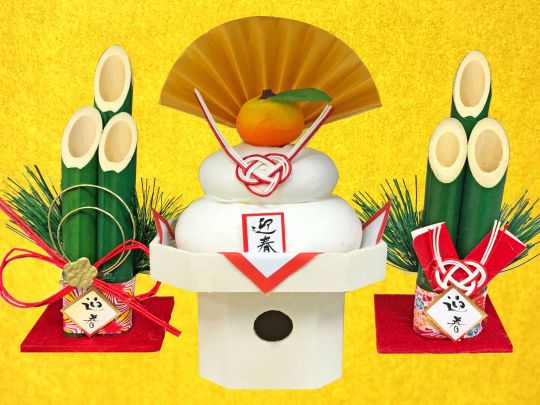
Just a quirky, middle of the night thought, despite not knowing if they are actually Cures or just Helpers. I'll try to think of intros later.
#wonderful precure!#pretty cure#precure#Daifuku Toyama#satoru toyama#cure names#ideas#kagami mochi#it just all seemed so fitting#cure kagami#cure mochi
10 notes
·
View notes
Text




Some items of interest out at the Portland Japanese Garden in Portland Oregon.
Top left: the item in the Tokonoma is called a Sumikazari. Three charcoal logs for the first tea ceremony of the new year.
Top right: Traditional new years toys, paddles and shuttlecock for playing hanetsuki, and koma, spinning tops.
Bottom left: Kagami Mochi. A traditional New Year's display.
Bottom right: The lower gate at the garden as you enter the grounds onto which a shimenawa has been affixed. Placing items such as this on an entryway of a home, or in this case, a garden, transforms the entryway into a portal of good fortune and protection. The Portland Japanese Garden has Matsukazari, Shime Kazari, and Shimenawa festooning the garden in a verity of locations.
The garden also offers Mizuhiki wreaths for sale in their gift shop while they last. This years wreaths were extra nice.

I chose to frame the wreath I got in a shadowbox to protect it.
#shinto#japan#japanese culture#new year traditions#tokonoma#sumikazari#hanetsuki#kagami mochi#matsukazari#shime kazari#shimenawa#mizuhiki wreaths
12 notes
·
View notes
Text

happy new year
9 notes
·
View notes
Text

We've got an assortment of lucky slimes to help you ring in the new year in the slime sticker club!! You get to choose one big slime and your finish (holo or matte) & you get all the month's designs as mini stickers! :) Join on my ko-fi page!
#vi draws#dragon quest#liquid metal slime#kagami mochi slime#kagami mochi#id in alt text#slime sticker club#stickers#sticker club
6 notes
·
View notes
Text
It's January 11, which means it's time for kagami biraki!
To conclude the Japanese New Year celebrations, kagami biraki, literally meaning "opening the mirror" or breaking of the mochi, is typically held on January 11. The term "kagami" translates to "mirror," and "biraki" means "opening" or "to break." The ceremony involves removing the round-shaped mochi from the family altar and breaking them into smaller pieces before cooking them in dessert or soup to enjoy. Eating the mochi symbolizes a prayer for health and good fortune in the New Year.
To break open the ornamental mochi, one should never cut it with a knife. The action is a reminder of ritual disembowelment from ancient times, and it is considered a sign of bad luck. For that reason, the customary way to break the mochi is with a wooden hammer or with one’s hands. These days, it's very common for people to buy a plastic decorative kagami mochi at a store, which the small mochi pieces are inside.
Kiku has prepared the mochi for the ceremonial opening - she even found a large wooden hammer like in ancient times. :D


After the mochi is broken open, it's customary to cook the smaller pieces in dessert or soup. A common dish is zenzai, which is red bean soup with mochi. That's what Kiku went for this year!

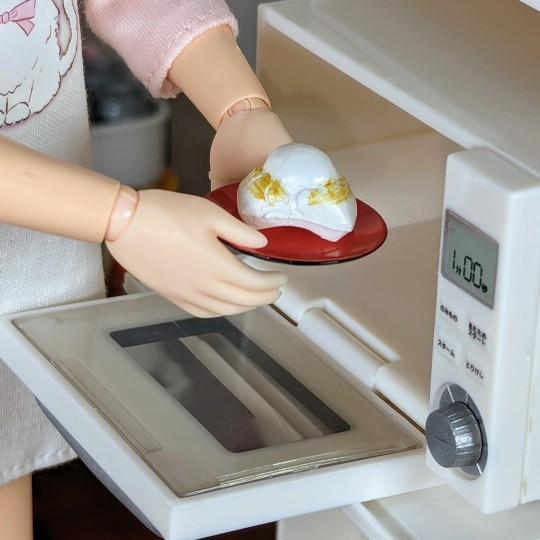
Time to enjoy that soup! Mmmm

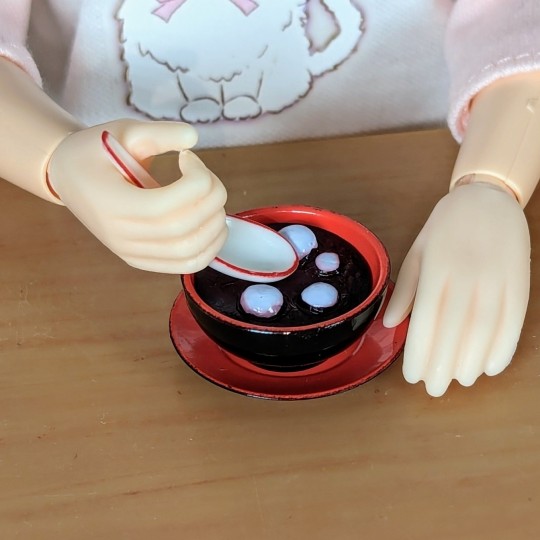
#my plastic life#tenderwolf#doll photography#one sixth scale#azone international#azone pure neemo#azonejp#kiku ningyo#japanese new year#kagami mochi#zenzai#rement#red bean soup#orcara#anime doll#mochi
22 notes
·
View notes
Text
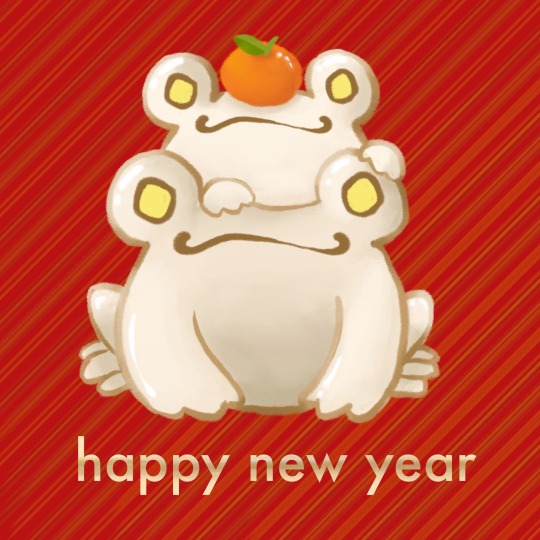
Happy froggy new year!
#artists on tumblr#frog#floris the frog#frog art#frogblr#frogcore#frogs#my art#digital art#happy new year#kagami mochi
13 notes
·
View notes
Text

Guess what?
It’s a rice cake for New year’s edition (the left side)
This Sanrio article says, we start a campaign.
Cinnamoroll of Sanrio collaborates between foods company this time.
We display this type of mochi (rice cake) during New year's weeks. It looks decorated cake, right?
We put one (orange) citrus on the top. 🍊
We call it as "Kagami-mochi".
Kagami means mirror, mochi is ordinary rice cake. I’m not sure reason why Kagami(mirror)is used.
*on Kanji ---> 鏡(kagami) + 餅(mochi)
#culture#character design#rice cakes#new year#Sanrio#cinnamoroll#mochi#kawaii#lovely#rice cake#Kagami mochi#Japan#kanji
3 notes
·
View notes
Text

This was one of the artworks that really needed some more adjustments. Especially to unify the colors. Adding more blue to the shadows makes the picture cooler and therefore more winter-y looking.
#retouched#improved#color adjustment#unifying colors#contrast#art#drawing#painting#digital art#japanese#winter#landscape#void cat#kagami mochi
3 notes
·
View notes
Text


Pekkle vs Kagami mochi by puroland_global
#stim#gifs#pekkle#sanrio#new years#kagami mochi#blue#yellow#white#mochi#mascots#sanrio puroland#ours
5 notes
·
View notes
Text
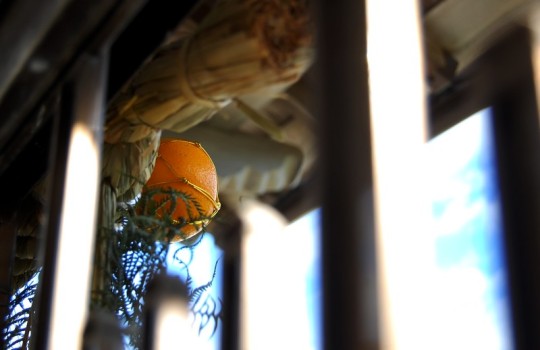
The beginning of a new year is like the beginning of a new chapter of life. It is time to put some things in the past and start anew. Probably it’s a universal custom to wish good luck for the fresh start of the year. And people must be doing that in many different ways in different parts of the world. Different things must be associated with good luck and happiness because of their shape, color and names. Here in Japan, people customarily relate lots of things in nature to good luck. Perhaps that is due to Shinto, the “indigenous faith” of this country. According to the faith, there are many deities residing in nature. Thus, ancient people might have seen the potentials in certain plants and animals in nature to mediate between human wishes and the deities.
Of course Japanese people today do not literally believe in the magical power of the deities and good luck charms. But they are still inclined to follow the custom just in case there is some unnatural power beyond our scientific knowledge. In rural areas, you can still find traditional customs that were lost in big cities decades ago. My hometown is no exception. For many grandpas here, getting correct plants for New Year’s decoration has the highest priority at the end of the year. For many grandmas, failing to buy certain food ingredients for New Year’s feast is a horrible mistake that they should avoid at all costs.
For those who may be interested in such Japanese traditions, let me share some of our family tradition of New Year’s celebration as of 2023.
The God of New Year – also the God of Agriculture – is said to visit every household on the New Year’s Day to stay for a certain period to give blessing for the whole year. This ornament is placed at the entrance to show him the way into the house.

This ornament, shimenawa is typically made with rice straw rope, ferns and an orange. And all of them are associated with good luck.
The rice straw is considered sacred because rice is the staple food here. The ferns have to be a special kind with leaves with white back. The white color is associated with gray hair, sybolizing “longevity.” The kind of orange used for this is “daidai orange” because “daidai” also means “from generation to generation” in Japanese language. Thus, this orange is associated with ”family prosperity.” To welcome the God of New Year, light is lit at the Shinto altar in the house on the night of New Year’s Eve.
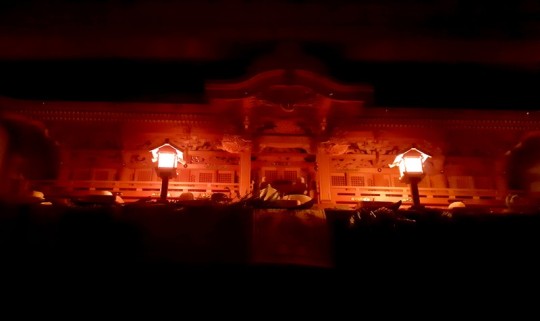
The altar is decorated with sacred rice straw ropes, talisman, rice cakes and offerings of sake, rice, salt and water.
The God is said to come onto this ornament with two big rice cakes. So it must be placed at the alcove beforehand.
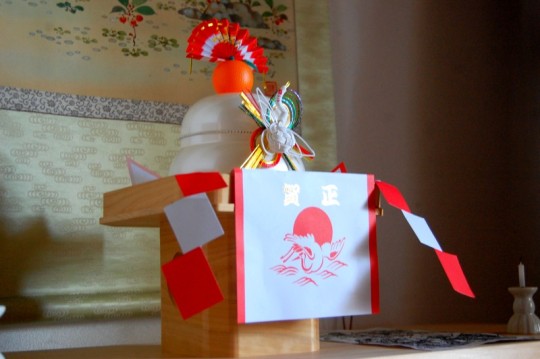
When I was a child, we made these rice cakes at home by pounding glutinous rice with mortar and pestle. They usually got hard and moldy in several days so we had to soak them in water and scrape off the moldy parts to eat them. Now we buy individually-wrapped small rice cakes in a plastic container which looks like two-tiered big rice cakes.
At midnight, as soon as the date turns to Jan. 1st, I go to this old, small shrine in my neighborhood for the first shrine visit of the year. My parents go to bed early, so I need to be there on behalf of them to pray for our family’s happiness and safety in the new year.


On Jan. 1st, I wake up early to see (and take photos of) the first sunrise of the year. This sunrise is considered to be special and give you blessing for the new year.

When my parents get up at around 10 am, it is time for a traditional ceremony to celebrate the New Year.
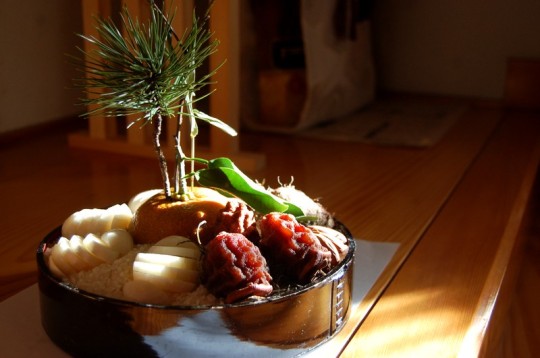
Before Meiji Restoation (1868), all people in Japan celebrated their birthdays on the same day, January 1st. So on New Year’s Day, they performed a ritual to celebrate getting one year older.
Now everyone in this country celebrates birthday independently on each person’s date of birth. But in some rural areas, people still do the ritual as a tradition on Jan. 1st and so does my family.
The most important object of the ceremony is this ornament called yone. It is literally an aggregation of ingredients symbolizing good luck.

The container is filled with raw rice, the staple food of this country. It is of special importance because it sustains people’s lives.
All the toppings are associated with good luck. Sliced mochi (rice cake) is sacred food made from the staple food. Daidai orange symbolizes “family prosperity” for the reason mentioned above. Thinly-cut kobu (kelp) symbolizes happiness and joy, with its pronunciation being similar to a Japanese word yorokobu, meaning “feeling happy.” Kachiguri (dried chestnuts which look like almonds in this photo) is associated with “victory” because kachi means "winning." Hoshigaki (dried persimmon) means longevity because persimmon trees live long and the Kanji characters for its name can be replaced with other characters meaning “bringing happiness.” Sprouting taro symbolizes ”prosperity of descendants” because it produces lots of tubers. Evergreen pine sprig is associated with “longevity.” Bamboo symbolizes “strength and sincerity” because it stays green in winter. And plum, which blooms earlier than others, is a symbol of “bright future.”
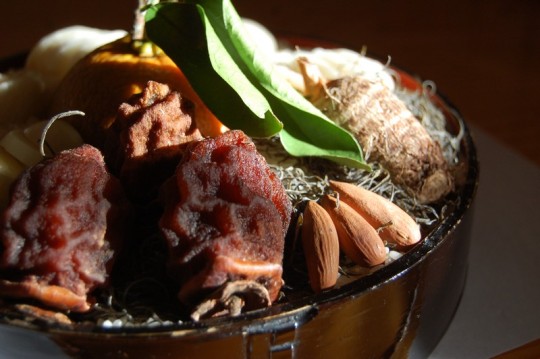
Family members gathered in the formal guest room take seats in front of the alcove and pass this ornament around. Starting with the head of the family, each person holds it with both hands a little higher than his/her head to thank God for their becoming one year older and pray for family’s happiness.
Then the person takes a sip of otoso, sake which is supposed to share some magical power of the God of the New Year. After purifying the body with the sacred sake, eating one piece of dried and grilled squid follows.
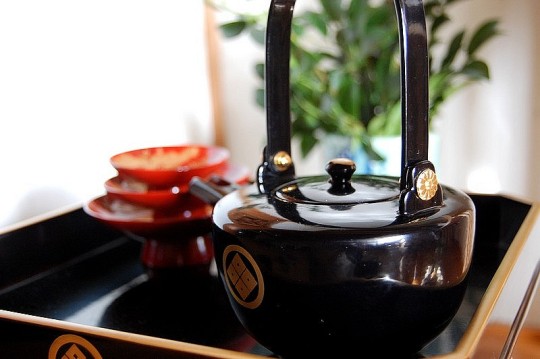
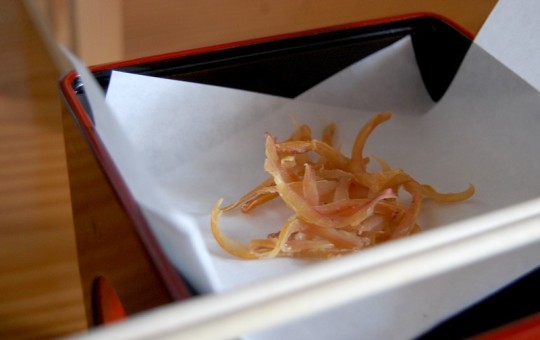
After the sake ritual, it is time for tasting zoni, rice cake soup. It is still part of the ritual, so only a small portion is served.


Our family’s zoni is VERY different. Usually some kind of vegetable is included in this soup. But our zoni has shredded kelp, yellowtail and rice cake cubes. That’s it. And lots of yellowtail bones are used for taking the broth. When my sister’s husband from a different prefecture tasted our zoni soup for the first time, he was almost overwhelmed by the strong fish flavor.
When I was a child, my mom put kimono (national traditional costume for formal occasions) on my sister and I for this special ceremony. And I was allowed to put some lipstick on only for the ceremony. Because of that, my lips felt strange while I was eating the zoni soup, but it felt very special. The ceremony takes place in a traditional Japanese style room. Basically family members have seats on the cushions placed on the tatami floor. It is not very comfortable, honestly speaking, so as soon as the rituals are done, my family always rush to the dining room. There, comfortably sitting in chairs, we enjoy osechi (New Year’s feast) with a bowlful of warmed zoni soup. And again, almost all foods are associated with good things like prosperity, health, longevity and good luck. Again, it is like all kinds of wishes packed in tiered lacquer food boxes.
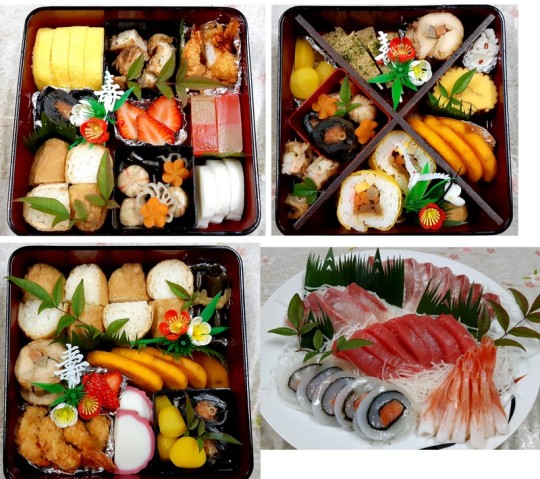

——– ——— ——–
So what do you think? The whole thing is an overwhelming degree of wish-making, isn’t it? Here people embody lots of wishes in so many ways. Living in a country prone to natural disasters may be part of the reason why.
Now everyone in Japan is educated with modern science. Younger generations do not literally believe in superstitions and/or traditional religious customs coming from Shinto and Buddhism. But still, people here seem to be trying to maintain the good thoughts underlying all the wish-making. And for me, wishing happiness for loved ones is not the matter of being scientific vs unscientific any more.
If making one’s wishes visible and touchable makes people stronger, more hopeful and motivated, maybe it is a wisdom rather than a blind obedience to unscientific nonsense. And traditional customs give the elderly something to pass down to the youth and make them feel being part of a big continuum. That’s the way I see this whole thing.
There is a beauty in it, I think … unless you become a slave of the tradition. ***********************
#new year's day 2023#shimenawa#traditional New Year's ceremony#kagami mochi#gantan#osechi#otoso#zoni
3 notes
·
View notes
Text
What’s Kagamibiraki and Tondo Yaki?
Tomorrow, January 15th, is the day we hold Kagamibiraki and Tondo Yaki in our area.
Kagamibiraki
Kagamibiraki is usually held on January 11th in most parts of Japan. However, in our area, the Kansai district, we hold it on January 15th, the same day as Tondo Yaki, every year.
We display kagamimochi, which are round and large rice cakes (mochi), for the New Year celebration. After two weeks, the mochi becomes hard. Instead of cutting it with a knife, which is considered unlucky, we break it by hand or sometimes use a wooden mallet. This process is called Kagamibiraki, which means “opening the mirror.”
The term “open” is used instead of “break” to symbolize good fortune. The word “kagami” refers to a sacred mirror in Shinto, and kagamimochi gets its name because its shape resembles a mirror.
After breaking the mochi, we toast it during Tondo Yaki and eat it. Eating kagamimochi is considered a way to bring good health and fortune for the year.
What’s Tondo Yaki?
Tondo Yaki is usually held on January 15th in most parts of Japan.
On this day, we gather at shrines, temples, or other large local spaces, bringing our New Year decorations, such as sanpo, kagamimochi wrappers, shimenawa, and kadomatsu. We also bring previous year’s talismans to be burned.
Bamboo, straw, and wood are used to build the fire. When it’s lit, the crackling sound of the bamboo is said to drive away evil spirits.
While the fire is burning, we toast kagamimochi to share with others and enjoy eating it together. Standing in the smoke or waving it toward yourself is believed to purify your body and bring blessings for the coming year.
Tomorrow, we will bring our talisman and shimenawa to my daughter’s kindergarten to participate in their Tondo Yaki. We only have a small kagamimochi, as you can see in my photo, but we will open it tomorrow and enjoy it as a family.
And this is our final event of New Year celebration.

0 notes

